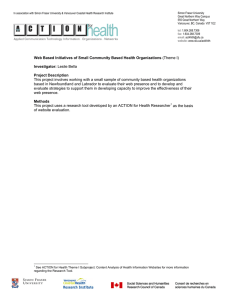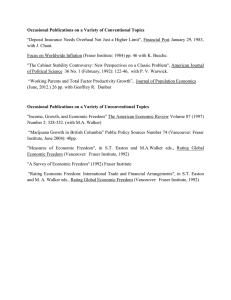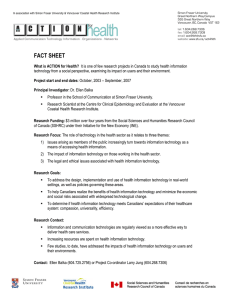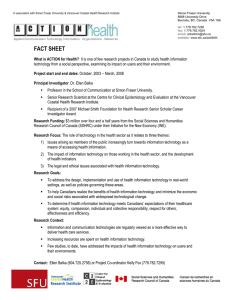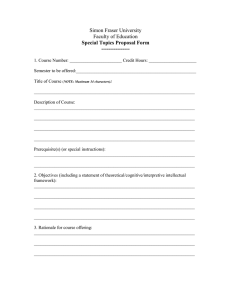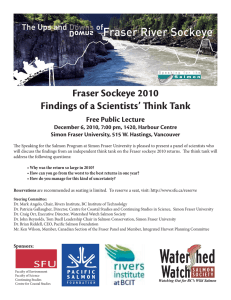The Fraser Institute is an independent Canadian economic and social... educational organization. It has as its objective the redirection of...
advertisement
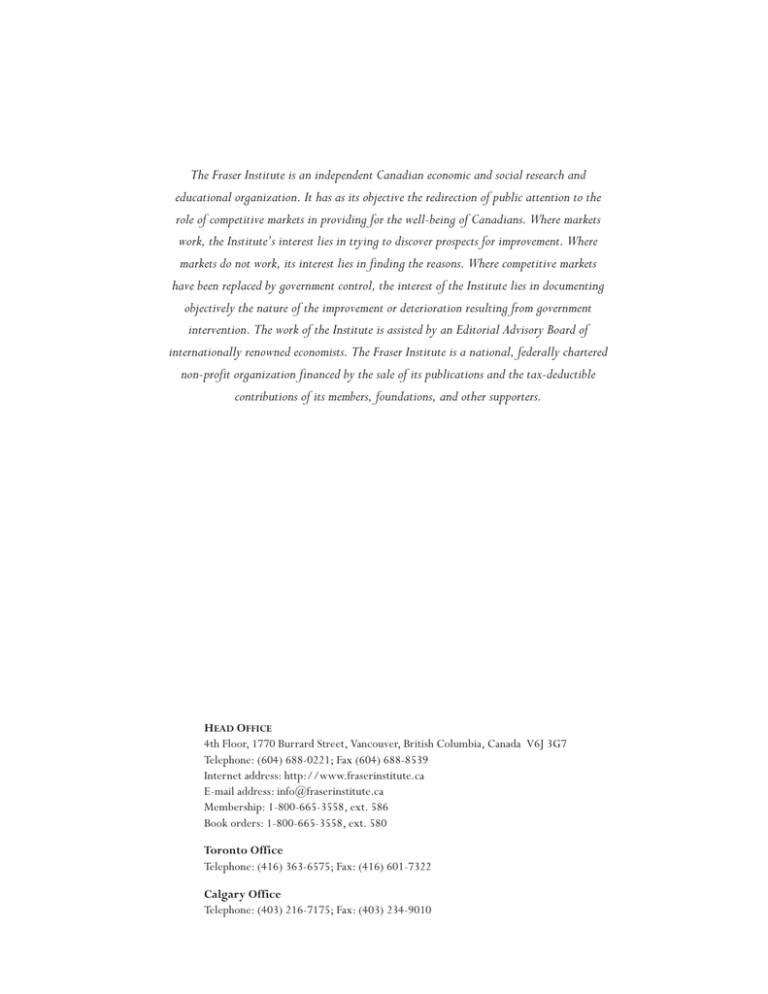
The Fraser Institute is an independent Canadian economic and social research and educational organization. It has as its objective the redirection of public attention to the role of competitive markets in providing for the well-being of Canadians. Where markets work, the Institute’s interest lies in trying to discover prospects for improvement. Where markets do not work, its interest lies in finding the reasons. Where competitive markets have been replaced by government control, the interest of the Institute lies in documenting objectively the nature of the improvement or deterioration resulting from government intervention. The work of the Institute is assisted by an Editorial Advisory Board of internationally renowned economists. The Fraser Institute is a national, federally chartered non-profit organization financed by the sale of its publications and the tax-deductible contributions of its members, foundations, and other supporters. HEAD OFFICE 4th Floor, 1770 Burrard Street, Vancouver, British Columbia, Canada V6J 3G7 Telephone: (604) 688-0221; Fax (604) 688-8539 Internet address: http://www.fraserinstitute.ca E-mail address: info@fraserinstitute.ca Membership: 1-800-665-3558, ext. 586 Book orders: 1-800-665-3558, ext. 580 Toronto Office Telephone: (416) 363-6575; Fax: (416) 601-7322 Calgary Office Telephone: (403) 216-7175; Fax: (403) 234-9010 THE FRASER INSTITUTE • 1999 • ANNUAL REPORT Chairman’s Report I t gives me great pleasure to report on the activities of The Fraser Institute during its twenty-fifth year of operation. It has been a year full of new accomplishments, of reminiscence about the developments over the past quarter-century, and of sadness at the passing of one of the most important people who contributed to the early success of The Fraser Institute. receive contributions from private sector foundations established for the purpose of funding research activities and other charitable enterprises. The Institute is very dependent upon these organizations for its existence, particularly because we refuse contributions from the public sector. In this regard, The Fraser Institute is unique amongst large research organizations in Canada. In writing this report it has given me considerable pleasure to revisit some of the Institute’s previous annual reports. As I did so, I took note of a number of things which have happened in that time, including the growth in the Institute’s resources, the number of employees, the growth in the use of the web site, and the number of stories about the Institute’s work in newspapers, on television, and on radio stations across the country. A number of charts have been created that show developments with regard to these aspects of the Institute’s operations, which I am sure you will find interesting. These graphs appear at different points throughout the annual report. The Institute’s anxieties about the potential implications of the Department’s finding were amplified when the Department refused charitable status to several organizations across the country seeking to follow The Fraser Institute model. The interpretation placed upon this by some, including Members of Parliament, was that Revenue Canada was determined to shut down organizations like The Fraser Institute because it disagreed with the views these institutes expressed. Considerable discussion with the Department determined that the difficulty encountered by the groups seeking to follow The Fraser Institute model (and by the Institute itself) were not of this sort. Rather, they were a byproduct of the Department’s ongoing attempt to develop its own position regarding public policy research institutes in the context of a broader examination of its charitable sector policy. The last few years have been a time of some danger for the Institute in ways that might not be immediately evident. The first source of danger is the level of success the Institute has enjoyed in changing the focus of the debate about economic and social policy. Success has a way of inducing complacency; that we have enjoyed a measure of success might have led us to rest on our laurels. In the ideas business it is particularly important not to do this. I’m happy to note that we have not permitted our success to lure us into complacency. In fact, 1999 was one of the strongest years of growth in the Institute’s history. We pursued new program areas and expanded our most important educational programs, programs that are key to the fulfilment of our educational function. I shall report later on some of these developments. The concern that the Institute has about its charitable status does not arise from the fact that the status enables us to provide a tax receipt for contributions made to the Institute by individuals. Rather, it is that such status makes us eligible to Finally, in October 1999, the Institute received a letter from the Department indicating that, apart from a number of minor technical issues which the Institute would have to address, the Department would not be pursuing the file at this time. I suppose that is as close as one gets to a clean bill of health from the Revenue Department. It does not, however, mean that the Department will not at some future time return to this issue and to a contemplation of the appropriateness of The Fraser Institute’s activities. The Institute will redouble its efforts to ensure that, while pursuing its mission, it continues to do so in the non-partisan, non-political ways which are permitted by our status under Revenue Canada’s policy. Premier Ralph Klein (centre left) accepts The Fraser Institute Fiscal Perfomance Award from Institute Chairman Raymond Addington, O.B.E. (centre right), Mr. William Siebens (left), and Executive Director Michael Walker following the 14th Annual Dr. Harold Walter Siebens Lecture, “The Alberta Advantage,” at the 1999 Annual General Meeting Round Table Luncheon. The Institute mounted several activities to mark its twentyfifth anniversary year including a 25-year retrospective book about the Institute and a gala dinner at which those who had made a significant contribution to the Institute’s founding and success were duly honoured. In all, 40 individuals were singled out for their contribution to the Institute and received a suitably inscribed memento of the occasion. We were very pleased that more than 300 members and guests were able to share this special occasion. Included amongst the guests were visitors from 24 countries including: Dr. Fernando Diego Alvarez (Argentina), Mr. Erwin Bendl (Austria), Prof. Subhash Kumar Sen Gupta (Bangladesh), Mr. Rodrigo Molina (Bolivia), Ms. Svetlana Alexandrova (Bul- Gary Wildman A second threat that we have faced in the last several years was the audit of our activities by Revenue Canada. The process was conducted in January 1998, but by the summer of 1999 had still not been reported upon. When finally the Revenue Department did report on the audit, it indicated that the Institute was not complying with the requirements for charitable organizations. The implication of this finding was of great potential significance for the Institute. 1 Three of the Fraser Institute’s founders reunite for the opening of the Institute’s new premises on Burrard Street in Vancouver on June 3: Mi c ha e l Walker (left), Sally Pipes, and Csaba Hajdu. brave project? Who else among the established and entrenched elites would have dared to take on the idea that nationalized health care socialism was anything other than Canada’s defining achievement as a nation? It has been fascinating to watch the turnaround in the major Toronto newspapers. The Toronto Star and the Globe and Mail have been legendary in their dismissal and even ridicule of The Fraser Institute’s health care work. Following the Institute’s first book on the subject, The Health Care Business, the Globe’s editorial called it “occult cynicism,” that would leave the rich to get regular check-ups while the poor get pleurisy. garia), Prof. Fan Gang, Dr. Xiaolu Wang, and Dr. Liwen Zhang (China), Dr. Rigoberto Stewart (Costa Rica), Ms. Dora Ampuero (Ecuador), Mr. Sigfrido Lee (Guatemala), Mr. Laszlo Urban (Hungary), Dr. Parth Shah (India), Dr. Rainer Adam and Dr. Anton Hermanto Gunawan (Indonesia), Mr. Giovanni Ronca (Italy), Mr. Young-Seok Yoo (South Korea), Mr. Paramjit Singh (Malaysia), Dr. Mahar Mangahas (Philippines), Dr. Andrzej Kondratowicz (Poland), Dr. Andrei Illarionov (Russia), Mr. Uwe Johannen (Singapore), Prof. Aleksandar Keseljevic and Mrs. Rotija Kmet (Slovenia), Mr. Håkan Borg and Mr. Mattias Bengtsson (Sweden), Dr. Nipon Poapongsakorn (Thailand), Prof. Guneri Akalin and Dr. Atilla Yayla (Turkey), and Dr. Abdiweli Ali, Dr. Alejandro Chafuen, Dr. James Gwartney, Dr. Robert Lawson, Dr. John Mukum Mbaku, and Prof. Walter Park (United States). The Toronto Star was even worse back then. But now, the Star routinely quotes the waiting list statistics that it once dismissed as a right wing fabrication. Mr. Corcoran went on in his remarks to note that, “In spite of the fact that the Institute has been in existence for 25 years, it has not become inured to its role in any way.” He added that, What is truly amazing to me is the fact that The Fraser Institute, after 25 years, has continued to maintain its intellectual sharpness and policy lead. The current work in the environmental area, especially in the areas of global warming and exposing the sinister spread of junk science throughout our culture, is a sign that the Institute is still a leader, still brave and bold, still able to take on the prevailing orthodoxies. I was especially encouraged to see The Fraser Institute participate in the smoking and tobacco debate. These are taboo subjects in academic circles in Canada. But The Fraser Institute is there. A feature of the gala celebration was the keynote address by Mr. Terence Corcoran, Editor of The Financial Post. In his wide-ranging discussion about the work of the Institute, Mr. Corcoran was generous in his assessment of our achievements. … I happen to consider the spread of junk science to be the greatest threat to freedom in the world today. If you and the Institute don’t take on these campaigns against junk science and junk economics, I don’t know who will. We’ve come a very long way since then, thanks to you... The price control book was the first of an incredible 25year record of production that has without doubt transformed the political and ideological climate in Canada. I’m very pleased to note that the Institute had already risen to Mr. Corcoran’s challenge and has in fact been in the process of creating a Risk and Regulation Centre which specifically focuses on issues related to junk science and their role in policy development. We had also, as Mr. Corcoran noted, taken the bold step of involving ourselves in the tobacco debate. Not, as some of our critics have attempted to maintain, because we favour or agree with the use of tobacco or the firms who produce it, but rather because of our concern that the debate about tobacco has been conducted in a “witch hunt” fashion with disregard for the evi- From the campaigns against rent controls, to the pathbreaking biennial Tax Facts reports that exposed the government’s relentless expropriation of our wealth and income, to the pay equity work, the studies of union economics, the pioneering privatization publications, the government spending analyses, the free trade leadership, the speakers series and meetings that have brought the world’s leading free market thinkers and politicians to Canada—these have all been instrumental in transforming the climate of ideas in Canada. There is no other institute in Canada that has made such a wide-ranging contribution, or had such a broad impact on the direction of public policy debate in Canadian life. Former Chairman of the Board, the late Mr. Alan Campney (left), and retired Trustee Mr. Bill Harrison, greet Alberta Premier Ralph Klein at the Institute’s Annual General Meeting in Vancouver, May 1999. The work in health care has been especially important. Some of us probably take for granted the books on health care and the waiting list research. But when you think about it, who else in Canada would have taken on such a 2 Gary Wildman Kristin McCahon THE FRASER INSTITUTE • 1999 • ANNUAL REPORT Dr. Liwen Zhang (left) and renowned Chinese economist Dr. Fan Gang of the National Institute for Economic Research in Beijing, China, meet in Vancouver to begin collaboration with the Institute on the production of a marketization index of the 31 Chinese provinces. dence on the subject. While those of us who do not smoke may have sympathy for a program which targets those who do (so we can be free of the irritation caused by their pesky habit), we have to recognize that in a free society the decision to remove others’ freedoms should only be taken after very careful deliberation and on the basis of facts rather than hysteria. The reason it was important to enter the tobacco debate is because it is an example of public policy based on prejudice rather than sound science. Through the activities of the Risk and Regulation Centre we will continue to challenge policy makers to ensure that their policies are based on sound foundations. While the Institute continues to innovate with new program areas, we have not neglected the projects in which the Institute has been engaged since its inception 25 years ago. For example, during 1999, Tax Freedom Day, the Institute’s index of the tax burden borne by ordinary Canadians, received more press attention across the nation than it has in its history. For many journalists and public policy analysts, Tax Freedom Day is the touchstone from which discussion about fiscal issues departs. tion document for discussions of policies regarding the alternative health care sector and an important source document for commentators. While alternative medicine is a challenging new area for public policy, the main focus of The Fraser Institute’s research program in health care is in conventional medicine, and in particular, how Canada’s socialized health care system functions. During 1999, the Institute added to the measurements that it makes of the health care system by issuing the firstever comprehensive report on the availability of medical technology in Canada. This report compared the technologies available in Canada with those available in other OECD countries and reported on direct hospital comparisons between Canada and the United States. It is hoped that this technology survey will become a regular aspect of the Institute’s health policy program. Other Institute calculations designed to inform the public policy debate also received widespread attention during the year. These include the environmental indicators, which in 1999 were expanded to include Mexico and the United Kingdom. The annual survey of mining companies was expanded to include the United States as well as foreign jurisdictions and has become an important addition to the discussion of mining policy in Canada and the United States. The survey of investment managers continues to be closely monitored by governments across the country; it reflects the opinions on crucial public policy issues of the investment managers who are the principal purchasers of the debt of the provinces and the federal government. Of course, those debts and other Canadian government obligations are the subject of the Institute’s annual Critical Issues Bulletin on Canadian government debt. The inclusion in the latter of the unfunded liabilities of provincial and federal governments has acquired an increasing amount of attention during 1999 as analysts begin to focus on The Fraser Institute’s concern about the promises to pay for health care and pensions obligations into which governments have entered. The future burden of these promises is reflected in the accumulating unfunded liability. One of the Institute’s newest measurement projects has been the creation of report cards for all of the high schools in British Columbia. During 1999, we issued the second comprehensive report card on high schools in British Columbia and once again collaborated with the Province newspaper to ensure that the results of this measurement were conveyed to its 200,000 readers. Reaction to the report card continues to reflect the wide range of interests which are affected by it, but there is also increasing recognition of the importance of performance measurement and continuous improvement in our school system. As I have often mentioned in this Annual Report, measurement is the very stuff of The Fraser Institute’s research program and during 1999 we ventured into some new areas of measurement. For example, in health care we published two studies which provided novel measurements of two critical aspects of the health care system. One of these was the first comprehensive survey of the use of alternative medicines ever conducted in Canada. This report has become the founda- Annabel Addington During 1999 we extended the report card measurement to include all of the high schools in Alberta. As an indication of the painstaking research which goes into Fraser Institute studies of this kind, in the case of both Alberta and British Columbia the report cards for each of the schools involves not only compiling the grades earned by every student in the school, but also measuring the socio-economic background from which each student of each school is drawn. The latter is derived by receiving from the Departments of Education the postal code of every student in a high school in each of the provinces and having Statistics Canada construct from its census measurement a socio-economic profile of each student, and therefore each school. The results of this analysis demonstrate quite clearly that some schools perform much better than the socio-economic characteristics of the student Left to right: Ms. Svetlana Alexandrova (Bulgaria), Ms. Dora Ampuero (Ecuador), Dr. Nipon Poapongsakorn (Thailand), and Mr. Sigfrido Lee (Guatemala) listen to the proceedings of the 1999 Economic Freedom Network annual conference held in the Institute’s Vancouver head office. 3 Annabel Addington THE FRASER INSTITUTE • 1999 • ANNUAL REPORT THE FRASER INSTITUTE • 1999 • ANNUAL REPORT body would predict, while others do much worse. The implication is that some principals have, to a greater degree than others, been able to work out a successful recipe for their schools. These successful schools in British Columbia, Alberta, and also Quebec, will be the subject of a special investigation by the Society for Excellence in Education, led by Ms. Helen Raham. Institute’s annual general meeting, during which he was very complimentary about The Fraser Institute’s work. It is an honour to be able to congratulate The Fraser Institute on 25 years of dedicated service on behalf of hard-working Canadians. You have made an important contribution to our country. Throughout your 25-year history, you have led the charge for fiscally responsible government and lower taxes. You have been the voice of reason, calling for a new way of governing and a break from the welfare state. You were the first to raise the call, and you have been diligent and vigilant in holding government feet to the fire. And it’s great to see that your diligence is paying off. Thanks in part to your ideas, reports, and studies—and the relentless pursuit of your ideals—governments in Canada are on the right path. We may still have a way to go yet, but we are finally headed in a direction that makes sense. Kristin McCahon One of the most interesting outcomes of the high school report card program has been the reaction of the principals of the ranked schools. Some have complained that the measurements treat them unfairly, others have welcomed the measurements as a helpful management tool. Others have suggested ways in which the measurements could be improved and the index made more accurate.But perhaps the most interesting insight into the importance of the report card exercise comes from the reaction of the principal of the British Columbia school which, in 1999, was ranked the worst school overall in the province. This principal, Mr. Michael McIndoe, was interviewed by BC Business Magazine, which did a cover story on British Columbia’s CEOs—chief education officers. When asked by the magazine how he felt about being ranked dead last, Mr. McIndoe replied: “It was the greatest leadership experience of my life.” In that interview, and in communication with The Fraser Institute, Mr. McIndoe noted that his school’s very poor showing in the report card mobilized the community behind him, and empowered him to do things which otherwise would not have been possible. Mr. McIndoe, in his correspondence with the Institute, noted that, “I want to thank you in the way that a patient thanks a dentist for a root canal.” In June, friends and supporters gather to celebrate the opening of The Fraser Institute’s new Vancouver offices. The Institute’s events department was busy during 1999, hosting many events from coast to coast in Canada, and in Chile and Argentina. Premier Mike Harris also complimented the Institute on its work. Both premiers noted that the Institute’s groundbreaking work had made it possible for them to pursue sensible economic policies; they could do so because the task of educating the general public had in many instances been done. It is important to note that The Fraser Institute is non-partisan and non-political in all of its activities, but the educational role that it plays makes a difference in how public discussion of policy change occurs. Two of Canada’s premiers and the governor of Oregon visited the Institute during 1999. Premier Ralph Klein provided the fourteenth Dr. Harold Walter Siebens Lecture at the Fraser Institute Employment Continues to Grow In September, the Institute hosted the Mont Pelèrin Society meeting in Vancouver. This is the third time The Fraser Institute has hosted the Mont Pelèrin Society, and as with previous meetings in Vancouver, the members noted that the 1999 meeting set a new standard of performance for meetings of this sort. The Institute was pleased to welcome to Vancouver former US Secretary of State George Shultz; Nobel Laureate Milton Friedman; former Prime Minister of the Czech Republic Vaclav Klaus; Wall Street Journal editor Robert Bartley; National Review editor-at-large John O’Sullivan; former Taiwanese Minister of Finance Ms. Shirley Kuo; International Monetary Fund Managing Director Stanley Fisher; former Chairman of Citicorp Walter Wriston; Mrs. Thatcher’s personal economic advisor, Sir Alan Walters; President of the Federal Reserve Bank of Cleveland, Dr. Jerry Jordan; and the man who invented the Hong Kong currency board system, Mr. John Greenwood. While the speakers just noted are illustri- Number of employees 35 30 25 20 15 10 5 0 1975 1980 1985 1990 1995 1999 4 THE FRASER INSTITUTE • 1999 • ANNUAL REPORT ous, members of the Mont Pelèrin Society are leading intellectuals from around the world, and for this particular meeting some 300 of them gathered to be led in discussions by their distinguished colleagues. Fraser Institute Program Spending Millions of dollars 5 During 1999, the Institute also hosted the meeting of the Economic Freedom Network. The Network is a group of 55 institutes in 55 countries that collaborates to produce the Economic Freedom of the World Index, which is the result of The Fraser Institute’s 14-year research program. A happy coincidence of this year’s meeting in Vancouver was the initiation of the collaboration of The Fraser Institute with the National Institute for Economic Research in Beijing, China, to produce a marketization index of the 31 Chinese provinces. This project, which has been funded by the Centre for International Private Enterprise, an affiliate of the American Chamber of Commerce, will see the construction over the next 5 years of a variety of indices that will ultimately enable market advocates in China to develop a comparative measurement of marketization in the Chinese provinces and document the effect of marketization. During the latter part of 1999, Dr. Liwen Zhang from the National Institute for Economic Research joined the staff of The Fraser Institute for training in the construction of indices of this type. 4 3 2 1 0 1975 1980 1985 1990 1995 1999 Nineteen-ninety-nine was also a year of great sadness for the Institute with the passing of Mr. Alan Campney, the first Chairman of The Fraser Institute’s Board of Trustees. Mr. Campney served the Institute as Chairman for 10 years during our early formative days when we frequently faced fundamental challenges. In the second year of our existence, one of the Institute’s most significant supporters demanded that the Institute withdraw a book which was intended for publication on the grounds that he disagreed with its conclusions. In response to this demand, Alan Campney crafted what can only be regarded as a classic defense of the importance of independence for an organization like The Fraser Institute. Since 1978, the Fraser Institute has been active in Latin America trying to convey to countries there the benefits of the Institute’s research. Over the years, it has been our pleasure to collaborate with many research institutes in Latin America. Nineteen-ninety-nine was no exception; we collaborated with institutes in Argentina and Chile in hosting international conferences on intellectual property rights. These conferences were well attended by the highest public officials as well as a good cross section of interested parties in both those countries. That letter served to establish once and for all the complete independence of the Institute’s research program, and the practice—which continues to this day—that the Board of Trustees and the Institute’s financial supporters do not receive copies of the Institute’s publications until after they have been published. While Alan Campney has been immortalized in this policy of independence for the Institute, those of us who worked closely with Alan will remember him for his sage advice and his ever-present sense of humour. We shall miss Alan Campney, who remained a member of the Executive Advisory Board of the Institute until the very end of his life. In memory of his great contribution to the Institute we will be establishing the Alan F. Campney Internship, which will be occupied each year by a promising young student who will work on policy issues at the Institute. Nineteen-ninety-nine marked a new level of outreach for the Institute as we began distributing Fraser Forum on news stands in British Columbia. This test program is designed to help the Institute devise a more saleable format for Fraser Forum to eventually put us in the position to be able to sell advertising in the magazine to help fund the Institute’s research program. There has, as yet, been insufficient experience with this program to judge whether news stand distribution is a viable option. Nineteen-ninety-nine also saw the establishment of the Pharmaceutical Policy Research Centre under the distinguished direction of Dr. William McArthur. Dr. McArthur is a Senior Fellow in Health Policy Analysis with the Institute and has, for the last four-and-a-half years, been conducting important research on a wide variety of topics, but particularly ones related to pharmaceutical policy. A major project of the Centre is the study of pharmaceutical cost containment policies, and how, and to what extent, they have worked to reduce the cost of health care provision. Nineteen-ninety-nine has been a record year for the Institute in many departments, and is an appropriately high level from which to launch our end-of-millennium year in 2000. I hope that you will join me in helping the Institute accomplish its ambitious goals for the forthcoming year, and that you will continue to provide the financial support which is crucial to its success. One of The Fraser Institute’s principal concerns is to ensure that its research results are made available to the broadest possible audience. One way to extend the reach of the Institute’s research is through our student programs, which are now conducted in 10 cities across Canada. The principal targets of these seminars are university students, of whom more than 1,000 participated last year. During 1999 a new form of seminar was targeted at high school students. Much to the surprise of the student programming staff, the experiment was a phenomenal success; nearly 400 high school students attended the first trial workshop in Vancouver. R. J. Addington, O.B.E. Chairman, The Fraser Institute 5 THE FRASER INSTITUTE • 1999 • ANNUAL REPORT Introducing The Fraser Institute T The Institute’s research agenda is decided by Institute staff at an annual planning session, and at a mid-year review. Ongoing projects are reviewed for their continuing relevance, and potential new projects assessed on the basis of importance and timeliness. The aim of the policy planning process is to produce a research and education plan that will maximize the Institute’s contribution to improving public policy. Donors are not involved in this planning process. he Fraser Institute was founded in 1974 to redirect the attention of Canadians to the role of markets in providing for their well-being. Over the long term, ideas are the most powerful influence on public policy. The Institute, therefore, stimulates demand for economically sound public policy by conducting research and disseminating its findings to the general public and to policy makers. Funding and Independence The Institute is headquartered in Vancouver, but also has satellite offices in Calgary, Toronto, and Ottawa. The Institute has active research ties with similar independent organizations in 54 countries from around the world. Throughout the year, funding is sought both for specific projects and for the Institute’s overall activities. The majority of the Institute’s revenues are derived from the donations of its members, and from research foundations. Revenue also is generated from the sale of publications, from Institute events, and from interest on invested endowment funds. The Institute avoids government funding, and strives to minimize its dependence on any single source of funding or group of supporters. The Institute is non-political, and does not undertake lobbying activities. Organization The Fraser Institute is a federally chartered, non-profit research and educational organization, with tax-exempt status in both Canada and the United States. Membership is open to anyone making a donation in support of the Institute’s activities. A Board of Trustees is responsible to the members of the Institute for the conduct of the Institute’s affairs. The Institute’s programs are administered by the Executive Director, and the Institute’s performance is monitored monthly by an Executive Advisory Board drawn primarily from the Board of Trustees. Publications and Outreach The Institute’s products—its ideas—are packaged in a number of different formats to reach different audiences. The Institute’s monthly magazine, Fraser Forum, its periodic Critical Issues Bulletins and Public Policy Sources, and its books are distributed to Institute members, the media, students, academics, policy makers, and politicians from all parties, across Canada and abroad. Research Institute publications have been sold in over 50 countries and translated into 20 languages. Many titles are required reading in North American and European universities. The Institute makes a particular effort to reach students through seminars, The Canadian Student Review newsletter, and internships. Institute publications since 1994 are also available in full on our web site. The objective of Institute research programs is to provide alternatives to well-intentioned but misguided views about the appropriate roles of governments. Research is carried out by Institute staff and by associated scholars from nearly 200 universities and other academic institutions around the world. Over 300 people have contributed to the Institute’s work, including Nobel Laureates Gary Becker, James Buchanan, Milton Friedman, and Douglass North. Research is reviewed internally by an editorial committee, and, where appropriate, by associated policy experts or an Editorial Advisory Board of leading international economists. The Institute reaches a wide audience through the mass media. Institute staff write press releases, editorials, and articles, and conduct radio and television interviews. The Institute also offers a fax news broadcasting service to over 200 radio talk show hosts nationwide. Further, the Institute’s National Media Archive monitors the media for balance in news and public affairs reporting. Finally, the Institute holds conferences, luncheons, and seminars in major Canadian cities,and Institute staff make speeches and participate in public forums on a regular basis. Institute staff also regularly make submissions to parliamentary committees. Lucretia Cullen Results The Fraser Institute’s efforts over the years have contributed to changing the conventional wisdom about many areas of public policy across Canada. The increasing scepticism Canadians feel about the efficacy of government solutions to economic problems is being reflected in the policy platforms of leaders across the political spectrum. The Institute has a well-deserved reputation for the quality of its work, which earns its research and recommendations the attention of policy makers around the globe. Executive Director Michael Walker (left) shares some conversation with former US Secretary of State the Honourable George Shultz and Stanley Fischer, First Deputy Managing Director of the International Monetary Fund (right) before the two square off in a debate at the Mont Pèlerin Society Regional Meeting held in Vancouver from August 29 to September 1, 1999. 6 THE FRASER INSTITUTE • 1999 • ANNUAL REPORT The National Media Archive M edia analysis at The Fraser Institute began in 1987 with the realization that what the media say about public policy issues frames the public debate. From its inception, the National Media Archive has been at the forefront of quantitative analysis of media content. Researchers at the NMA examine news content using a sophisticated method that examines every sentence, phrase, and even word to determine whether the Canadian media are balanced in their coverage of social, economic, and political issues. The Archive’s comprehensive, scientifically-based research reveals the limitations, imbalances, and one-sided nature of many media reports. establishing a media monitoring unit. After conducting several content analyses of the Australian federal election and of labour issues, Ms. Morrison returned to Canada to pursue a Master’s degree in Communications. The NMA maintains a video and text library of CBC and CTV’s national news and public affairs programs, as well as the text of all major Canadian daily newspapers. These resources are made available to academics, students, and the general public in Canada and throughout the world for research purposes. The Archive is a member of the International Media Monitoring Association (IMMA), an organization dedicated to sharing research findings and methods, and conducting comparative studies. The collaborative work is published quarterly by the German Media monitoring unit. In 1999, the Archive continued to examine television attention to issues such as bank mergers, productivity, and risk and the environment. It expanded its research activities to examine the online content of the national broadcaster. In its analysis of CBC’s online web site it revealed that the public broadcaster emphasized the opinions of left-wing organizations in its in-depth news content. The analysis on the CBC web site was not limited to news content. During the year we also took a close look at the CBC4Kids site and examined its coverage of poverty. Based in The Fraser Institute’s Alberta office, National Media Archive Director Lydia Miljan presented the findings of the Archive during 1999 on a wide variety of television and talk radio programs, as well as in opinion pieces in major Canadian newspapers. Gary Wildman A protester takes issue with the findings of The Fraser Institute-published book, Passive Smoke: the EPA’s Betrayal of Science and Policy. Eager media scrums question Alberta Premier Ralph Klein (above) and Ontario Premier Mike Harris (below) following their respective Fraser Institute speeches in Vancouver on May 10 and November 30. An Adam Smith tie is a perfect fit! Michael Walker makes a presentation to Bank of Canada Governor Gordon Thiessen (left) of the Institute’s new millennium tie following Mr. Thiessen’s speech to an Institute Round Table Luncheon in December. Gary Wildman Gary Wildman Kristin McCahon During 1999, the National Media Archive, in the person of Kate Morrison, continued to assist the Institute of Public Affairs (IPA) in Melbourne, Australia, in 7 THE FRASER INSTITUTE • 1999 • ANNUAL REPORT Fiscal Studies Division T he most widely recognized work of any public policy institute in Canada is “Tax Freedom Day”—the day in the year when the average family has earned enough income to pay the total tax bill levied by the various levels of government. This calculation, which The Fraser Institute has been making for 22 years, is an important fixture in the debate about government spending and taxation in Canada. The Fiscal Studies division annually calculates Tax Freedom Day for Canada as well as for each of the provinces. A new variation was added in 1999. Now, anyone can log onto our web site at www.fraserinstitute.ca and, by providing a few pieces of information, obtain their Personal Tax Freedom Day estimate, including the number of days worked for the government, and an estimate of how many of these days were required to pay for specific types of government spending. readers, as well as the compilation of both the Fiscal Performance Index and the Budget Performance Index. The Fraser Institute awarded Ralph Klein his third straight Fiscal Performance Award in 1999. The award is based on the semiannual Fiscal Performance Index, which follows a model constructed by the Washington, DC-based CATO Institute. This index compares the performances of the provincial and state governments, relative to each other, on key taxation and spending measures from election through to the current year. The Budget Performance Index compares the recent taxation, spending, deficit, and debt performance of the provinces and the federal government. The division researches many other important issues affecting Canadians. “Canadian Government Debt 1999: A Guide to the Indebtedness of Canada and the Provinces,” provides background information to help Canadians understand the size and nature of the nation’s public debt and obligations. This comprehensive measure of Canada’s obligations includes: the direct debt, debt guarantees, contingent liabilities, and contractual commitments of Canada and the provinces, the debt of taxpayer-supported Crown Corporations, total program obligations for the Canada and Quebec Pension Plans, the Old Age Security program, and the health care system. A thorough list of statistics such as interest burdens and foreign currency exposure by province is included. In addition, the report compiles the Severely Indebted Country list for 146 countries, along with the 10 Canadian provinces and two territories. Tax Facts 11, the Institute’s biennial book about the Canadian tax system, was released in 1999. Tax Facts provides a detailed province-by-province analysis of the total direct and hidden tax bill as well as an overview of taxation in Canada and an analysis of how Canada compares with other countries. Two other studies related to taxation were released in 1999. “Using Cash Rebates for Tax Relief Without Risk” showed that there is a way for the federal government to give Canadians tax relief without risking a return to deficits. “The 20% Foreign Property Rule: Increasing Risk and Decreasing Returns on RRSPs and RPPs” discussed the problems with the foreign property rule and provided empirical examples of how the rule lowers retirement income for Canadians. The quarterly Investment Managers Survey, based on the responses of senior investment officers who collectively manage over $175 billion worth of assets, provides insight into such topics as provincial investment climates, budget recommendations, productivity, and the brain drain, and gives approval ratings for both the federal finance minister and the Bank of Canada governor. Another area of focus is the implications of the size of governments in Canada and the provinces, and the related questions of how surpluses should be allocated. “Canadian Public Spending: The Case For Smaller, More Efficient Government” makes the case that the Canadian government sector is too large, that this has negatively affected rates of economic growth and living standards, and proposes a path to reduce government from 45 to 30 percent of GDP. The Fraser Institute hosted the first in a series of symposia on capital gains taxation. The 1999 meeting brought together Canadian and American experts in the field for a productive one-day session. In addition, the division provides federal and provincial budget analyses, basic background information on issues ranging from public sector employment to agricultural subsidies to international unemployment rates for Fraser Forum “The Case for the Amero: The Economics and Politics of a North American Monetary Union,” details how Canada’s flexible exchange rate regime has contributed to poor economic performance, high currency-exchange costs, and added a significant risk premium to Canadian interest rates. The paper explains how a monetary union among Canada, the United States, and Mexico would benefit all three countries. Pedram Panahi “The Adequacy of Welfare Benefits” is a detailed analysis of the incomes available to welfare recipients. It examines how these incomes compare to basic needs and to the incomes of the working poor, and concludes that welfare incomes cover basic needs for all except those recipients who society expects to work. The division will continue to have a diverse focus.It will cultivate an awareness of how and why tax and debt burdens differ among provinces. It will examine how Canadian governments spend and tax relative to each other, the United States, and other nations. In addition, it will look at what policy options will ensure a sound fiscal future for Canada. David Somerville Chair in Canadian Fiscal Studies and former MP Herbert Grubel (left), former Governor of the Bank of Canada John Crow (centre), and Jason Clemens, Director of Fiscal and Non-Profit Studies at The Fraser Institute, participate in a panel discussion at the Mont Pèlerin Society Regional Meeting. 8 continued ...
